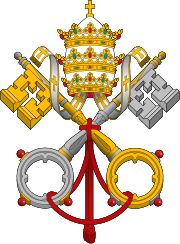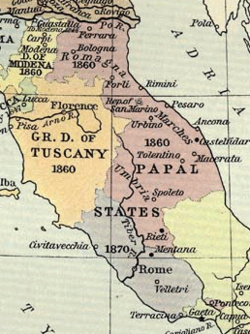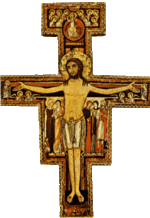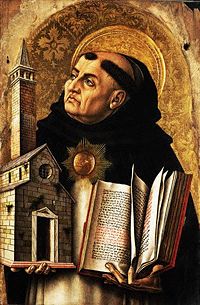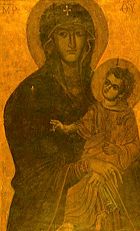Papal States
|
|||||||||||||||||||||||||||||||||||||||||||
The Papal States, State(s) of the Church or Pontifical States (in Italian Stato Ecclesiastico, Stato della Chiesa, Stati della Chiesa or Stati Pontificii) were one of the major historical states of Italy from roughly the 6th century until the Italian peninsula was unified in 1861 by the Kingdom of Piedmont-Sardinia (after which the Papal States, in less territorially extensive form, continued to exist until 1870). The Papal States comprised those territories over which the Pope was the ruler in a civil as well as a spiritual sense before 1870. This governing power is commonly called the temporal power of the Pope, as opposed to his ecclesiastical primacy.
The plural Papal States is usually preferred; the singular Papal State (equally correct since it was not a mere personal union) is rather used (normally with lower-case letters) for the modern State of Vatican City, an enclave within Italy's national capital, Rome. Vatican City was founded in 1929, again allowing the Holy See the practical benefits of territorial sovereignty.
Contents |
Origins
The Christian Church spent its first three centuries as an outlawed organization and was thus unable to hold or transfer property. Early Christian churches congregated in the audience halls of well-to-do individuals, and a number of Early Christian churches built round the edges of Ancient Rome were ascribed to patrons who held the property in custody for the Church: see titulus. After the ban was lifted by the Emperor Constantine I, the Church's private property grew quickly through the donations of the pious and the wealthy; the Lateran Palace was the first significant donation, a gift of Constantine himself. Other donations soon followed, mainly in mainland Italy but also in the provinces, but the Church held all of these lands as a private landowner, not as a sovereign entity. When in the fifth century the Italian peninsula passed under the control of first Odoacer and then the Ostrogoths, the church organization in Italy, and the bishop of Rome as its head, submitted to their sovereign authority while beginning to assert spiritual supremacy.
The seeds of the Papal States as a sovereign political entity were planted in the sixth century. The Eastern Roman (or Byzantine) government in Constantinople launched a reconquest of Italy that took decades and devastated the country's political and economic structures; just as those wars wound down, the Lombards entered the peninsula from the north and conquered much of the countryside. By the seventh century, Byzantine authority was largely limited to a diagonal band running roughly from Ravenna, where the Emperor's representative, or Exarch, was located, to Rome and south to Naples. With effective Byzantine power weighted at the northeast end of this territory, the Bishop of Rome, as the largest landowner and most prestigious figure in Italy, began by default to take on much of the ruling authority that Byzantines were unable to project to the area around the city of Rome. While the Bishops of Rome — now beginning to be referred to as the Popes — remained de jure Byzantine subjects, in practice the Duchy of Rome, an area roughly equivalent to modern-day Latium, became an independent state ruled by the Church.
The Church's relative independence, combined with popular support for the Papacy in Italy, enabled various Popes to defy the will of the Byzantine emperor; Pope Gregory II even excommunicated emperor Leo III the Isaurian. Nevertheless the Pope and the Exarch still worked together to control the rising power of the Lombards in Italy. As Byzantine power weakened, though, the Papacy took an ever larger role in defending Rome from the Lombards, usually through diplomacy, threats and bribery. In practice, the papal efforts served to focus Lombard aggrandizement on the Exarch and Ravenna. A climactic moment in the founding of the Papal States was the agreement over boundaries embodied in the Lombard king Liutprand's Donation of Sutri (728) to Pope Gregory II [1].
The Donation of Pepin and the Holy Roman Empire
When the Exarchate finally fell to the Lombards in 751, the Duchy of Rome was completely cut off from the Byzantine Empire, of which it was theoretically still a part. Pope Stephen II acted to neutralize the Lombard threat by courting the de facto Frankish ruler, Pepin the Short. With the urging of Pope Zachary to depose the Merovingian figurehead Childeric III, Pepin was crowned in 751 by Saint Boniface. Stephen later granted Pepin the title Patrician of the Romans. Pepin led a Frankish army into Italy in 754 and 756. Pepin defeated the Lombards taking control of northern Italy and made a gift (called the Donation of Pepin) of the properties formerly constituting the Exarchate of Ravenna to the Pope. In 781, Charlemagne codified the regions over which the Pope would be temporal sovereign: the Duchy of Rome was key, but the territory was expanded to include Ravenna, the Pentapolis, parts of the Duchy of Benevento, Tuscany, Corsica, Lombardy and a number of Italian cities. The cooperation between the Papacy and the Carolingian dynasty climaxed in 800, when Pope Leo III crowned Charlemagne the first "Emperor of the Romans" ('Augustus Romanorum').
However, the precise nature of the relationship between the Popes and Emperors — and between the Papal States and the Empire — was not clear. Was the Pope a sovereign ruler of a separate realm in central Italy, or were the Papal States just a part of the Frankish Empire over which the Popes had administrative control? Or, on the other hand, were the Holy Roman Emperors vicars of the Pope (as a sort of Archemperor) ruling Christendom, with the Pope himself, however, being directly responsible only for the environs of Rome and then delegating the rest to the Emperor in order to concentrate on his spiritual duties? Events in the 9th century postponed the conflict: the Frankish Empire collapsed as it was subdivided among Charlemagne's grandchildren, and the papacy's prestige declined, with the tyranny of the local Roman nobility in the tenth century, into the condition later dubbed the pornocracy, or "rule by harlots". [1] In practice, the Popes were unable to exercise effective sovereignty over the extensive and mountainous territories of the Papal States, and the region preserved its old Lombard system of government, with many small countships and marquisates, each centered upon a fortified rocca.
Over several campaigns in the mid-tenth century, the German ruler Otto I conquered northern Italy; Pope John XII crowned him emperor (the first so crowned in more than forty years), and the two of them ratified the Diploma Ottonianum, which guaranteed the independence of the Papal States. Yet over the next two centuries, Popes and Emperors squabbled over a variety of issues, and the German rulers routinely treated the Papal States as part of their realms on those occasions when they projected power into Italy. A major motivation for the Gregorian Reform was to free the administration of the Papal States from imperial interference, and after the extirpation of the Hohenstaufen dynasty, the German emperors rarely interfered in Italian affairs. By 1300, the Papal States, along with the rest of the Italian principalities, were effectively independent.
From 1305 to 1378, the Popes lived in Avignon, in what is now France, and were under the influence of the French kings in what was known as the 'Babylonian Captivity'. During this Avignon Papacy, however, much of the Papal States in Italy remained only formally under Papal control; in fact, 1357 marks a watershed in the legal history of the Papal States, when Cardinal Albornoz promulgated the Constitutiones Sanctæ Matris Ecclesiæ, which replaced the mosaic of local law and accumulated traditional 'liberties' with a uniform code of civil law. The promulgation of the Constitutiones Egidiane followed the military progress of Albornoz and his condottieri heading a small mercenary army. Having received the support of the archbishop of Milan and Giovanni Visconti, he defeated Giovanni di Vico, lord of Viterbo, moving against Galeotto Malatesta of Rimini and the Ordelaffi of Forlì, the Montefeltro of Urbino and the da Polenta of Ravenna, and against the cities of Senigallia and Ancona. The last holdouts against full papal control were Giovanni Manfredi of Faenza and Francesco II Ordelaffi of Forlì. Albornoz, at the point of being recalled in 1357, in a meeting with all the Papal vicars, 29 April 1357, issued the Constitutiones; they remained in effect until 1816.
During this period the city of Avignon itself was added to the Papal States; it remained a papal possession even after the popes returned to Rome, only passing back to France during the French Revolution.
The Renaissance
During the Renaissance, the papal territory expanded greatly, notably under Popes Alexander VI and Julius II. The Pope became one of Italy's most important secular rulers as well as the head of the Church, signing treaties with other sovereigns and fighting wars. In practice, though, most of the Papal States was still only nominally controlled by the Pope, and much of the territory was ruled by minor princes. Control was always contested; indeed it took until the 16th century for the Pope to have any genuine control over all his territories.
At its greatest extent, in the 18th century, the Papal States included most of Central Italy — Latium, Umbria, Marche and the Legations of Ravenna, Ferrara and Bologna extending north into the Romagna. It also included the small enclaves of Benevento and Pontecorvo in southern Italy and the larger Comtat Venaissin around Avignon in southern France.
The era of the French Revolution and Napoleon

The French Revolution proved as disastrous for the temporal territories of the Papacy as it was for the Catholic Church in general. In 1791 the Comtat Venaissin and Avignon were annexed by France. Later, with the French invasion of Italy in 1796, the Legations were seized and became part of the revolutionary Cisalpine Republic. Two years later, the Papal States as a whole were invaded by French forces, who declared a Roman Republic. Pope Pius VI died in exile in France in 1799. The Papal States were restored in June 1800 and Pope Pius VII returned, but the French again invaded in 1808, and this time the remainder of the States of the Church were annexed to France, forming the départements of Tibre and Trasimène.
With the fall of the Napoleonic system in 1814, the Papal States were restored. From 1814 until the death of Pope Gregory XVI in 1846, the Popes followed a harshly reactionary policy in the Papal States. For instance, the city of Rome maintained the last Jewish ghetto in Western Europe. There were hopes that this would change when Pope Pius IX was elected to succeed Gregory and began to introduce liberal reforms.
Italian nationalism and the end of the Papal States
Italian nationalism had been stoked during the Napoleonic period but dashed by the settlement of the Congress of Vienna (1814–15), which left Italy divided and largely under Habsburg Austrian domination. In 1848, nationalist and liberal revolutions began to break out across Europe; in 1849, a Roman Republic was declared and Pope Pius IX fled the city. Louis Napoleon Bonaparte, recently elected president of the newly declared French Second Republic, saw an opportunity to assuage conservative Catholic opinion in France, and in cooperation with Austria sent troops to restore Papal rule in Rome. After some hard fighting (in which Giuseppe Garibaldi distinguished himself on the Italian side), Pius was returned to Rome, and repenting of his previous liberal tendencies pursued a harsh, conservative policy even more repressive than that of his predecessors. However, Pius did continue to build railroads, telegraphs, and gas lights.
In the years that followed, Italian nationalists — both those who wished to unify the country under the Kingdom of Sardinia and its ruling House of Savoy and those who favored a republican solution — saw the Papal States as the chief obstacle to Italian unity. Louis Napoleon, who had now seized control of France as Emperor Napoleon III, tried to play a double game, simultaneously forming an alliance with Sardinia and playing on his famous uncle's nationalist credentials on the one hand and maintaining French troops in Rome to protect the Pope's rights on the other.
After the Second Italian War of Independence, much of northern Italy was unified under the House of Savoy's government; in the aftermath, Garibaldi's expedition of the Thousand overthrew the Bourbon monarchy in the Kingdom of the Two Sicilies. Afraid that Garibaldi would set up a republican government in the south, the Sardinians petitioned Napoleon for permission to send troops through the Papal States to gain control of the Two Sicilies, which was granted on the condition that Rome was left undisturbed. In 1860, with much of the region already in rebellion against Papal rule, Sardinia conquered the eastern two-thirds of the Papal States and cemented its hold on the south. Bologna, Ferrara, Umbria, the Marches, Benevento and Pontecorvo were all formally annexed by November of the same year, and a unified Kingdom of Italy was declared. The Papal States were reduced to the Latium region surrounding Rome, raising the Roman Question.
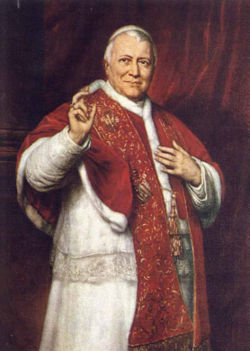
Rome was declared the capital of Italy in March 1861, when the first Italian Parliament met in the kingdom's old capital Turin in Piedmont. However, the Italian Government could not take possession of its capital, because Napoleon III kept a French garrison in Rome protecting Pope Pius IX. The opportunity to eliminate the last vestige of the Papal States came when the Franco-Prussian War began in July 1870. Emperor Napoleon III had to recall his garrison from Rome for France's own defence and could no longer protect the pope. Following the collapse of the Second French Empire at the battle of Sedan[2], widespread public demonstrations demanded that the Italian Government take Rome. King Victor Emmanuel II sent Count Ponza di San Martino to Pius IX with a personal letter offering a face-saving proposal that would have allowed the peaceful entry of the Italian Army into Rome, under the guise of offering protection to the pope.
- The Pope’s reception of San Martino (10 September 1870) was unfriendly. Pius IX allowed violent outbursts to escape him. Throwing the King’s letter upon the table he exclaimed: "Fine loyalty! You are all a set of vipers, of whited sepulchres, and wanting in faith." He was perhaps alluding to other letters received from the King. After, growing calmer, he exclaimed: "I am no prophet, nor son of a prophet, but I tell you, you will never enter Rome!" San Martino was so mortified that he left the next day.[3]
On September 10, Italy declared war on the Papal States, and the Italian Army, commanded by General Raffaele Cadorna, crossed the papal frontier on 11 September and advanced slowly toward Rome, hoping that a peaceful entry could be negotiated. The Italian Army reached the Aurelian Walls on 19 September and placed Rome under a state of siege. Although the pope's tiny army was incapable of defending the city, Pius IX ordered it to put up at least a token resistance to emphasize that Italy was acquiring Rome by force and not consent. The city was captured on September 20 1870. Rome and Latium were annexed to the Kingdom of Italy after a plebiscite held in the following October.
According to Raffaele De Cesare[4]:
- The Roman Question was the stone tied to Napoleon’s feet — that dragged him into the abyss. He never forgot, even in August 1870, a month before Sedan, that he was a sovereign of a Catholic country, that he had been made Emperor, and was supported by the votes of the Conservatives and the influence of the clergy; and that it was his supreme duty not to abandon the Pontiff. [p. 440]
- For twenty years Napoleon III had been the true sovereign of Rome, where he had many friends and relations… Without him the temporal power would never have been reconstituted, nor, being reconstituted, would have endured. [p. 443]
This event, described in Italian history books as a liberation, was taken very bitterly by the Pope. The Italian government had offered to allow the Pope to retain control of the Leonine City on the west bank of the Tiber, but Pius rejected the overture. Early the following year, the capital of Italy was moved from Florence to Rome. The Pope, whose previous residence, the Quirinal Palace, had become the royal palace of the Kings of Italy, withdrew in protest into the Vatican, where he lived as a self-proclaimed "prisoner", refusing to leave or to set foot in St. Peter's Square, and forbidding (Non Expedit) Catholics on pain of excommunication to participate in elections in the new Italian state.
However the new Italian control of Rome did not wither, nor did the Catholic world come to the Pope's aid, as Pius IX had expected. In the 1920s, the papacy — then Pius XI — renounced the bulk of the Papal States and signed the Lateran Treaty (or Concordat with Rome) of 1929, which created the State of the Vatican City, forming the sovereign territory of the Holy See (which is also a subject under international law in its own right). Vatican City can be seen as the modern descendent of the Papal States.
Institutions
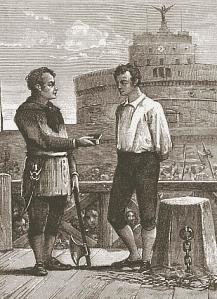
- As the plural name Papal States indicates, the various regional components, usually former independent states, retained their identity under papal rule. The papal 'state' was represented in each(?) province by a governor, either styled papal legate, as in the former principality of Benevento, or Bologna, Romagna, and the March of Ancona; or papal delegate, as in the former duchy of Pontecorvo.
- The police force, known as sbirri ("cops" in modern Italian slang), was stationed in private houses (normally a practice of military occupation) and enforced order quite rigorously.
- For the defence of the states an international Catholic volunteer corps, called zouaves after a kind of French colonial native Algerian infantry, and imitating their uniform type, was created.
References
- This article incorporates text from the entry States of the Church in the public-domain Catholic Encyclopedia of 1913.
- De Cesare, Raffaele (1909). The Last Days of Papal Rome. London: Archibald Constable & Co.
- Luther, Martin (1521). Passional Christi und Antichristi. Reprinted in W.H.T. Dau (1921). At the Tribunal of Caesar: Leaves from the Story of Luther's Life. St. Louis: Concordia. (Google Books)
Footnotes
- ↑ Emile Amann and Auguste Dumas, ""L'église au pouvoir des laïques", in Auguste Fliche and Victor Martin, eds. Histoire de l'Église depuis l'origine jusqu'au nos jours, vol. 7 (Paris 1940, 1948). Liutprand of Cremona's biased account is adjusted by Bernard Hamilton, "The monastic revival in tenth-century Rome" and "The House of Theophylact and the promotion of the religious life among women in tenth-century Rome", both articles collected in Hamilton's Monastic Reform, Catharism and the Crusades (900-1300 (London, 1979).
- ↑ After the defeat of Napoleon III at Sedan, Garibaldi went to France and assumed command of the Army of the Vosges, an army of volunteers that was never defeated by the Germans. (see Giuseppe Garibaldi)
- ↑ De Cesare, Raffaele (1909). The Last Days of Papal Rome. London: Archibald Constable & Co.
- ↑ *De Cesare, Raffaele (1909). The Last Days of Papal Rome. London: Archibald Constable & Co.
Sources, references, and external links
- WorldStatesmen: Italy
- WHKMLA Historical atlas: here the page offering numerous links to maps of/containing Italy
See also
- Avignon Papacy
- Donation of Constantine
- History of Rome
- Holy Roman Empire
- Italian unification
- Vatican City
- Prisoner in the Vatican
- War of the Eight Saints
- Captain General of the Church
External links
|
|||||||||||||||||||||||||||||||||||||||||||||
|
||||||||||||||||||||||||||||||||||||||||||
|
|||||||||||||||||||||||||||||||||||||||||||||

